Ouroboros
Animated geometric shapes and colors in a video installation on the history of the universe
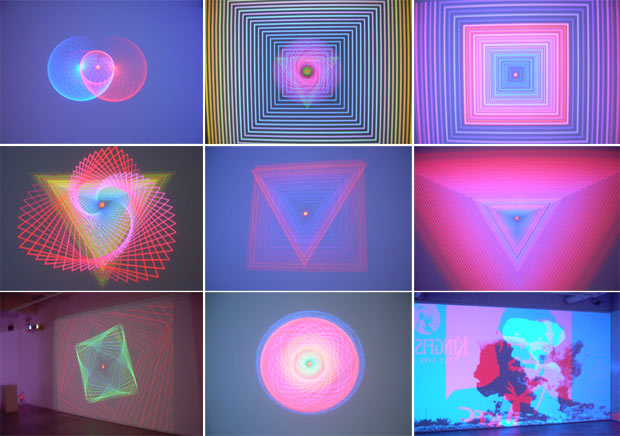
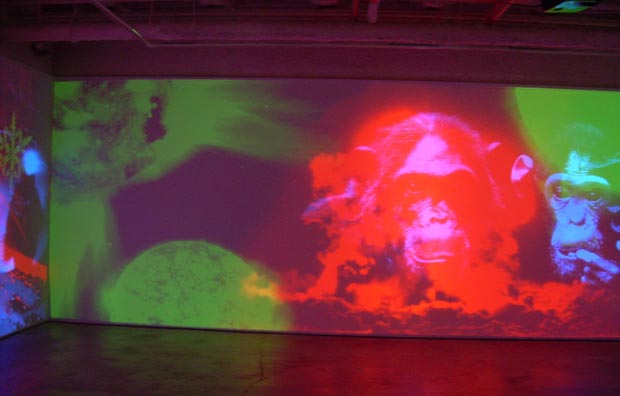
The video exhibit “Ouroboros” at ISE Cultural Foundation explores the creation and history of the universe, using the iconic image of a snake eating itself as center to the work. The piece consists of six projections in 3-D, using geometric shapes and imagery to transform the space.
This compellingly unique mix of science and art fits the talents of Ourobos’ creators exactly. Renaissance man Ali Hossaini, and video artists/programmers Blake Shaw and Bruno Levy of Sweatshoppe, collaborated on the piece. Ourobos combined Hossaini’s “investigations into the psychology of vision” and Sweatshoppe’s software and tech know-how.
In an interview with the artists, they discussed the project.
What’s Ouroboros about?
Ali: It was an ode to the history of the universe in three layers: the physical, the biological and the psychological. The material world, the life world and the cultural world. I did about 30,000 into different files, just arranged them sequentially. And then we talked about what would work where.
Bruno: When we came down to the gallery, we realized there’s more of a story that can be told. We had been doing this basic geometry and these shapes for awhile. And what we really liked about them was they had this energy, and this thing where you look at them and you become entranced.
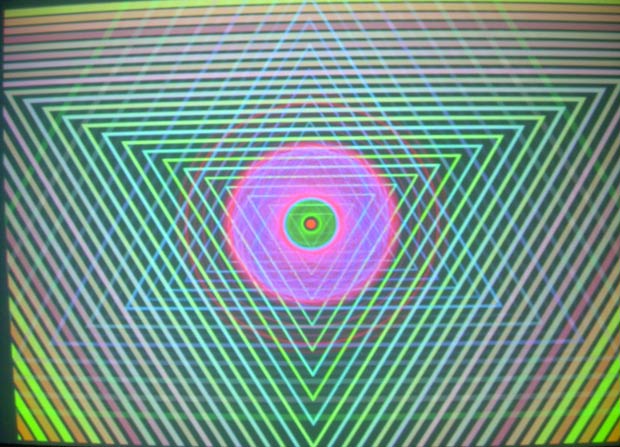
How did you meet?
Blake: We started trying to figure out a way to create 3-D video in real time about a year ago, writing a piece of software that allowed us to create anaglyph video, which is like the red and blue glasses. But we quickly realized that that effect is old and outdated, and it also gives you a headache quickly. So we started working with ChromaDepth. Right about the time that we finished the software, we were doing a performance at Jonathan LeVine Gallery. And it was an event that Ali was producing for the Metropolis Art Prize. Instantly when he saw our effect he went, “Oh man, that’s awesome!”
Ali: It was pure chance, actually, because I was producing this art competition and the awards were going to be given at the Jonathan LeVine gallery. And I walked in when they were setting up. I’d been wanting to do 3-D for this concept of Ouroboros, which was a history of the universe told through juxtaposed images, and I’d worked in 3-D before. When I saw what they did, it just seemed so on target for what I wanted to do and I think their work is really expressive and it’s a really powerful aesthetic. I’d never seen anything like it before.
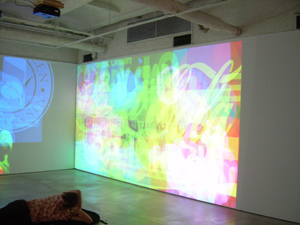
What led you to combine images and geometry?
Bruno: we just have these really simple geometric shapes that are being animated through space, or through depth, and they’re connecting and recreating other shapes when they cross. We basically have these three different layers that are looping with different start and end points. So they’re kind of looping on top of another on top of another and creating different shapes. And when they cross, they create different colors.
We’ve been really into mandalas and yantras and all these symbols or these machines that are meant to be these geometric shapes that you look at that elevate your consciousness. But we would almost rejuvenate them or recreate them using this psychedelic, technology driven 3-D media. And try to bring them to life.
Blake: We’re looking at simple geometry as the atomic unit. And we’re moving from simple geometry to more complex geometry. And then from complex geometry to representational imagery. And we’re also trying to address the higher experience of the cosmos. Considering we only can understand the world from our immediate human perspective, we’re trying to break you free of that and open your consciousness to greater dimensions of reality.
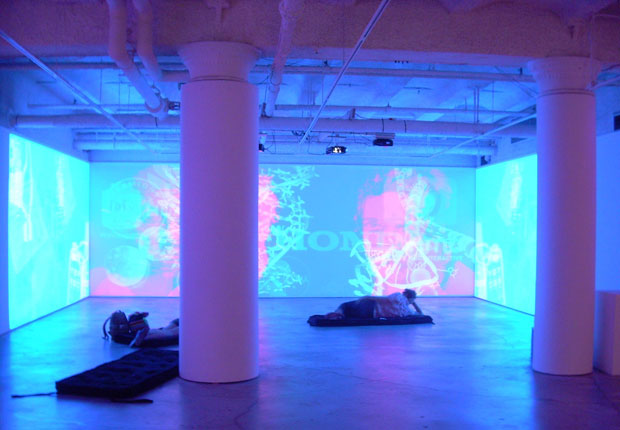
Ouroboros runs through 30 April 2010. Read more of the interview after the jump.

The marriage of music and projections, set to a pervading beat, help create this transcendental space. How did you create the music?
Blake: Ali appropriated all these images from the internet. So I thought it would really be appropriate to make the music with audio appropriated from the internet. But we were really trying to create something that was soothing and very meditative, and really something that brings your heart rate down and allows you to relax and be in this heavy space.
Bruno: Since we were sometimes making video for performances, which are live performances which go to a certain bpm. We were looking into different binaural frequencies that affective the brain and stimulated the brain or created meditative states.
That’s also really important when you’re trying to create an environment that you want people to spend time in. I think it’s pretty awesome, people just seem to sit here for along time.
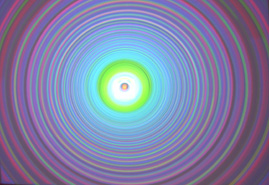
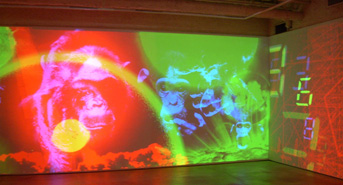
How do you hope people will think about and experience Ouroboros?
Ali: I think what we’re aiming for here in the installation is a feeling of psychological integration. I think art can connect all the different parts of the universe together. And artists don’t really try to do that. But I think all of us are coming to that place where we feel a social responsibility to make art.
And even the layout of the installation—it’s roughly inspired by a mandala or a sybil, an alchemical walk, or even the stations of the cross where you have a psychological journey. You start with the geometric symbols and then you move to the yantras, and then you move into the scientific or representational world, and then you move back into geometry. As you go to the end of the room and look at this piece it’s completely different. I think overall people seem to have that feeling, peacefulness, when they come out of here, which is what we’re looking for, to feel whole again.
Bruno: We didn’t know how people would generally react. We didn’t know, in the space, if people would pass out on the floor and hang out for a bit, or think it was corny or cheesy in a way. And I think for us it’s really about creating this experience, it’s about art as experience.
Ali: By putting this stuff together, people start to interpret, start to create meaning.
There’s this creative act on the part of the audience that is really, really important too.
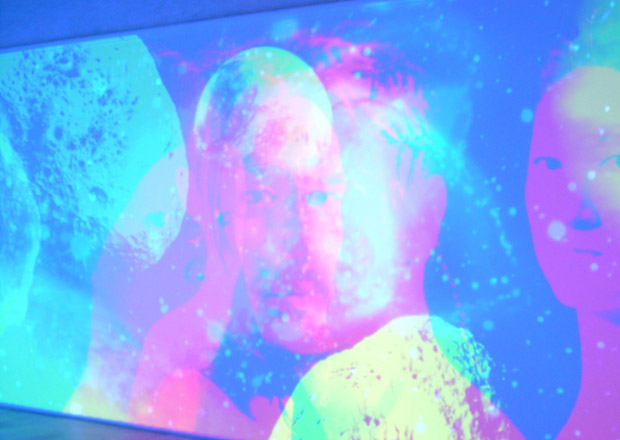
Blake and Bruno, you recently formed art duo Sweatshoppe, which creates and plays with much of the technology used in Ouroboros. What does Sweatshoppe do?
Blake: We do this thing where we paint video on the street. like, we roll up to a wall and we plug this paint roller in that we made and it allows us to create the illusion that we’re painting a video on the wall.
Bruno: The reason why we invented that, actually, was we wanted to have this performance where people could come out at some point in the performance and start painting the walls of the space, so that the walls were evolving, and all of a sudden you’d been in the desert, and things flying around and we started playing with mapping software because we wanted to change the environment of the space.
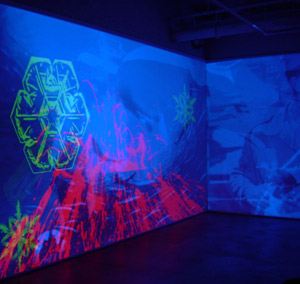
Ali, where do you come from with your work? What drew you to telling a history of the universe through film?
Ali: I think art has to adapt to the time, and people obviously take most of their experiences in from screens. I think if Americans are watching TV screens like six hours a day, they’re comfortable with screens. One of the things that makes me happy about Ouroboros and working with Sweatshoppe is there’s no feeling that people have to be reverent towards the art. I think actually art should be just this thing that you come to when you feel like it, and then you leave, but it’s always there: you can tap into it. Also I love the medium of video and computer digital technologies. I think they’re really empowering and you can do these things that twenty, thirty years ago people couldn’t imagine doing.
To me it’s been really liberating working in this medium, but I do want to push the boundaries of what we’ve done here. Ok, people can make YouTube videos, but how do you make a whole video environment? That’s something that really intrigues me. I think we’re going to be living in these video environments more and more.
30,000 images is a lot to work with. How did you organize and sequence them?
Ali: There’s three layers: matter, life and spirit. Originally, I’d assigned each one to a color. But then I found that got really monotonous, and originally this was supposed to go from the Big Bang up to the present day, and go chronologically. But that felt really didactic and monotonous, too. So, that’s were the poetry of it came in.
If you try to be too conceptual or consistent then it just feels sterile. The technology is really fresh, the techniques, this stuff is just being created as we were making the installations. So there was this feeling of discovery throughout.
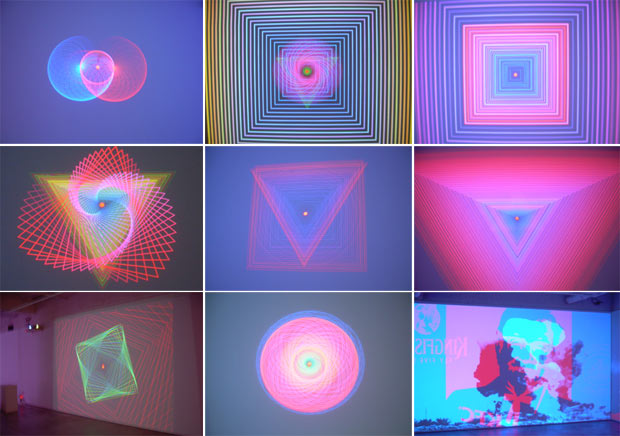
The imagery also includes logos, like Starbucks. Why did you decide to include logos?
Ali: It’s supposed to be a history of our environment, and logos are so much a part of our environment; they represent the rise of corporations. The logos actually evolve. You see these organic forms like vegetables, and then leaves and flowers, and then you’ll see these japanese crests, which are based on organic forms. And they’re early logos. And then you see actual designed logos. But below that you’ll see the development of agriculture, and the corporitization of agriculture that goes on. So the logos actually encroach on a lot of things. And then at some point it’s just all logos.
Corporations and these imperative are about the colonization of the life world, and the mental world. And I’m not saying corporations are all bad, but they are related with a lot of the developments, like war and things. I thought that was just an integral part of the story—of our universe, anyway.












